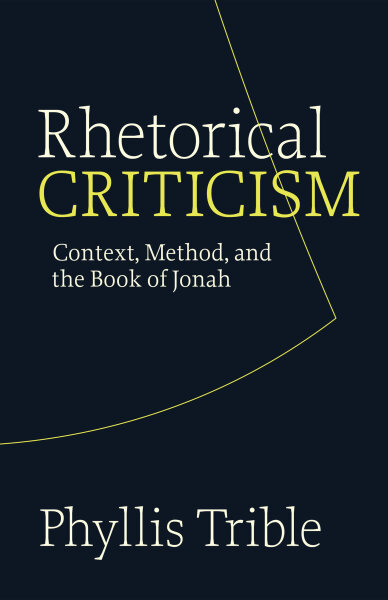Phyllis Trible examines rhetorical criticism
as a discipline within biblical studies. In
Part One she surveys the historical
antecedents of the method from ancient times
to the postmodern era: classical rhetoric,
literary critical theory, literary study of
the Bible, and form criticism. Trible then
presents samples of rhetorical analysis as
the art of composition and as the art of
persuasion.
In Part Two, formulated guidelines are applied to a detailed study of the book of Jonah. A close reading with respect to structure, syntax, style, and substance elicits a host of meanings embedded in text, enabling the relationship between artistry and theology to emerge with clarity.
Rhetorical Criticism has many distinctive features. It is
In Part Two, formulated guidelines are applied to a detailed study of the book of Jonah. A close reading with respect to structure, syntax, style, and substance elicits a host of meanings embedded in text, enabling the relationship between artistry and theology to emerge with clarity.
Rhetorical Criticism has many distinctive features. It is
- the first comprehensive treatment of biblical rhetorical criticism as it has emerged within the latter half of the twentieth century.
- a didactic treatise that combines theoretical discussion, practical guidelines, and detailed exegesis
- interdisciplinary in approach, engaging the rhetorical study of the Bible with expanding developments in secular literary criticism (structuralism, poetics, reader-response criticism, and deconstruction, for example) and in the similarly burgeoning field of contemporary rhetoric
- itself a model of the rhetorical analysis that it describes
- accessible both to the novice and to the scholar
- Publisher Fortress Press
- Format Paperback
- ISBN 9780800627980
- eBook ISBN 9781451416176
- Dimensions 5.5 x 8.5
- Pages 280
- Publication Date January 3, 1995
Endorsements
"This book was written on several levels and will engage a range of readers to their benefit. I refrain from comment [on the contents] lest I spoil the surprise--and delight--for the reader. Suffice it to say that the book itself is an example of rhetoric."
--Gene M. Tucker,
Emory University
--Gene M. Tucker,
Emory University
Table of Contents
Editor's Foreword
Preface
Abbreviations
Prologue
Part One
Context
1. Sketching the Background
2. Introducing the Foregrund
3. Expanding the Background
Part Two
Method and the Book of Jonah
4. Guidelines for Beginning
5. External Design of Jonah
6. Internal Structure of Scene One (1:1-16)
7. Internal Structure of Scene One (2:1-11)
8. Internal Structure of Scene Two (3:1-10)
9. Internal Structure of Scene Two (4:1-11)
10. Guidelines for Continuing
Appendices
a. The Book of Jonah: A Study in Structure
B. Quiz
Indexes
Authors and Editors
Hebrew Words
Scripture
Subjects
Preface
Abbreviations
Prologue
Part One
Context
1. Sketching the Background
2. Introducing the Foregrund
3. Expanding the Background
Part Two
Method and the Book of Jonah
4. Guidelines for Beginning
5. External Design of Jonah
6. Internal Structure of Scene One (1:1-16)
7. Internal Structure of Scene One (2:1-11)
8. Internal Structure of Scene Two (3:1-10)
9. Internal Structure of Scene Two (4:1-11)
10. Guidelines for Continuing
Appendices
a. The Book of Jonah: A Study in Structure
B. Quiz
Indexes
Authors and Editors
Hebrew Words
Scripture
Subjects
